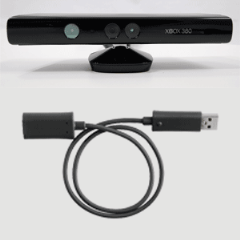 NEWS
NEWS
 NEWS
NEWS
 NEWS
NEWS
![]() Redmond based Microsoft recently announced the due date of its Kinect for Windows project that will bring their much-vaunted hardware out of the gaming console and into the arena of the PC platform. The hardware and software is planned to be available starting February 1st, 2012 in 12 countries including the US, Canada, Mexico, and much of Europe.
Redmond based Microsoft recently announced the due date of its Kinect for Windows project that will bring their much-vaunted hardware out of the gaming console and into the arena of the PC platform. The hardware and software is planned to be available starting February 1st, 2012 in 12 countries including the US, Canada, Mexico, and much of Europe.
Looking at what the device did for the Xbox console, bringing it to PC is late in coming but should hopefully spark a swath of innovation and interesting developments for the peripheral.
At a starting price point of $249 it seems a little bit expensive—the Kinect alone for the Xbox is $149—although it’s possible to get it for a lower $149 price-point if you qualify for academic pricing. At this price, the bundle will include not just the Kinect for Windows hardware, but all the software needed to make it function with a PC and also a 1-year warranty and access to Windows-based software advancements in human motion tracking, gesture, facial tracking, speech support, and all the amazing things that Kinect does for the Xbox.
“We love the innovation we have seen built using Kinect for Xbox 360,” wrote Microsoft on their Kinect for Windows Team blog announcing the product, “this has been a source of inspiration and delight for us and compelled us to create a team dedicated to serving this opportunity. We are proud to bring technology priced in the tens of thousands of dollars just a few years ago to the mainstream at extremely low consumer prices.”
Microsoft goes on to explain the decision as to why the higher price point, “And although Kinect for Windows is still value-priced for the technology, some will ask us why it isn’t the same price as Kinect for Xbox.”
If anything should have taught the software-giant about the Kinect’s mainstream appeal it’s that it’s been accessible to the common-hacker at a reasonable price that has spread interest in the subject. Placing it at a price +$100 from what the Xbox console peripheral costs will provide an undue obstacle. Plus, people have already ported it to use on PC in spite of not having any software for Windows available.
It will be very nice to have that software as a foundation for a new experience with the PC-platform, but Microsoft is really shooting themselves in the foot in overall reach if they want to enlarge the appeal of this product.
Microsoft themselves has seemed caught off-guard by the spellbounding pragmatic function of the Kinect technology even though they themselves continue to fascinate audiences with what people do with it. They’ve even started a website called The Kinect Effect that promotes what people have done in the past with the product and where they continue to go with it.
We’ve seen engineers connect the Kinect to Nao robots to perform simple telepeoperative actions; medical imaging companies combined the hands-free gesture-detection for touchless manipulation of information during surgery; and innovated to aid instruction in gesture-based languages such as American Sign Language.
Microsoft has been leading the way into regions where the Kinect could have a great deal of sway but in some ways it feels like they’ve been dragging their feet. In November, the software-giant started signups for the Kinect Accelerator program, but the best-and-brightest we’ve seen so far haven’t come out of Microsoft programs yet. The company also started a partnership with Sesame Street to combine education with interactive entertainment.
Come February and the announcement of the subjects of the March to May three-month Accelerator project we will probably see an explosion of Kinect-related innovation, software and technology.
We hope it’s impressive, because we’ve been watching this product with its million-erg potential for a while now and it has yet to really hatch.
THANK YOU